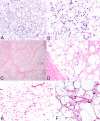Lipoblastoma Arising in the Head and Neck: A Clinicopathologic Analysis of 20 Cases
- PMID: 37486535
- PMCID: PMC10514009
- DOI: 10.1007/s12105-023-01575-5
Lipoblastoma Arising in the Head and Neck: A Clinicopathologic Analysis of 20 Cases
Abstract
Background: Lipoblastomas (LPBs) are benign adipocytic neoplasms believed to recapitulate the development of embryonal fat.
Methods: We investigated the clinicopathologic and immunohistochemical features of 20 lipoblastomas arising in the head and neck in 18 patients.
Results: Patients included 6 males and 12 females (1:2 ratio) with age at diagnosis ranging from 4 months to 28 years. Tumors occurred more commonly in the neck (12, 66.7%) and less commonly in the forehead, scalp, and tongue (2, 11.1%). Tumor size ranged from 1.4 to 6.0 cm (median 5.0 cm). Two patients, a 4-month-old female and 3-year-old male, had local recurrence of neck tumors at 4 months and 3 years after excision, respectively. Microscopically, tumors had a lobulated growth pattern and consisted of adipocytes at varying stages of differentiation. In addition to the classical histologic features, lipoma-like and myxoid variants constituted 45% of cases. Metaplastic elements, including brown fat and cartilage, were identified in two cases.
Conclusions: LPBs arising in the head and neck region are not uncommon and occurred at a rate of 9% in our cohort. They should be kept in the differential diagnosis when a fatty tumor is encountered in an older child or occurring at an unusual location.
Keywords: Lipoblast; Lipoblastoma; Lipoma; Neck; PLAG1.
© 2023. This is a U.S. Government work and not under copyright protection in the US; foreign copyright protection may apply.
Conflict of interest statement
No conflict of interest to disclose.
Figures




Similar articles
-
Lipoblastomas presenting in older children and adults: analysis of 22 cases with identification of novel PLAG1 fusion partners.Mod Pathol. 2021 Mar;34(3):584-591. doi: 10.1038/s41379-020-00696-4. Epub 2020 Oct 23. Mod Pathol. 2021. PMID: 33097826
-
New molecular insights into the pathogenesis of lipoblastomas: clinicopathologic, immunohistochemical, and molecular analysis in pediatric cases.Hum Pathol. 2020 Oct;104:30-41. doi: 10.1016/j.humpath.2020.07.016. Epub 2020 Jul 18. Hum Pathol. 2020. PMID: 32692992
-
Lipoblastoma-like tumor of the vulva: further characterization in 8 new cases.Am J Surg Pathol. 2015 Sep;39(9):1290-5. doi: 10.1097/PAS.0000000000000448. Am J Surg Pathol. 2015. PMID: 25929353
-
Undifferentiated myxoid lipoblastoma with PLAG1-HAS2 fusion in an infant; morphologically mimicking primitive myxoid mesenchymal tumor of infancy (PMMTI)--diagnostic importance of cytogenetic and molecular testing and literature review.Cancer Genet. 2016 Jan-Feb;209(1-2):21-9. doi: 10.1016/j.cancergen.2015.11.004. Epub 2015 Nov 18. Cancer Genet. 2016. PMID: 26701195 Review.
-
Benign intrascrotal lipoblastoma in a 4-month-old infant: a case report and review of literature.J Pediatr Surg. 2011 Jul;46(7):E9-12. doi: 10.1016/j.jpedsurg.2011.03.012. J Pediatr Surg. 2011. PMID: 21763825 Review.
Cited by
-
PLAG1-Rearranged Fibromyxoid and Lipomatous Neoplasms in Children and Adults: Separate Entities or a Morphological Spectrum?Genes Chromosomes Cancer. 2025 Aug;64(8):e70070. doi: 10.1002/gcc.70070. Genes Chromosomes Cancer. 2025. PMID: 40879223 Free PMC article.
-
Primary scrotal lipoma in a child: a rare case report and review of literature.Front Pediatr. 2024 Oct 30;12:1360943. doi: 10.3389/fped.2024.1360943. eCollection 2024. Front Pediatr. 2024. PMID: 39539765 Free PMC article.
References
-
- The WHO Classification of Tumours Editorial Board . WHO classification of tumours soft tissue and bone tumours. 5. Lyon: IARC Press; 2020.
Publication types
MeSH terms
LinkOut - more resources
Full Text Sources
Medical

